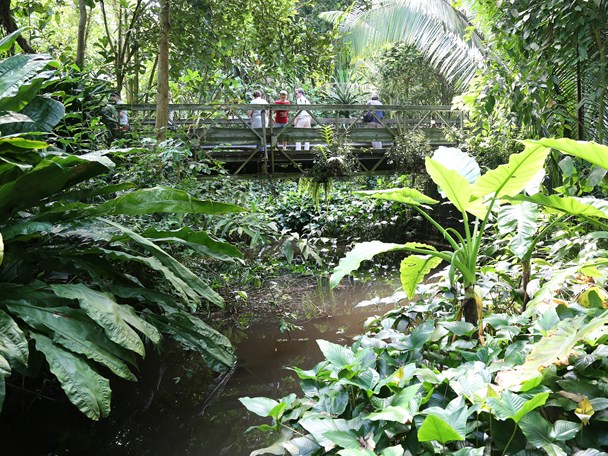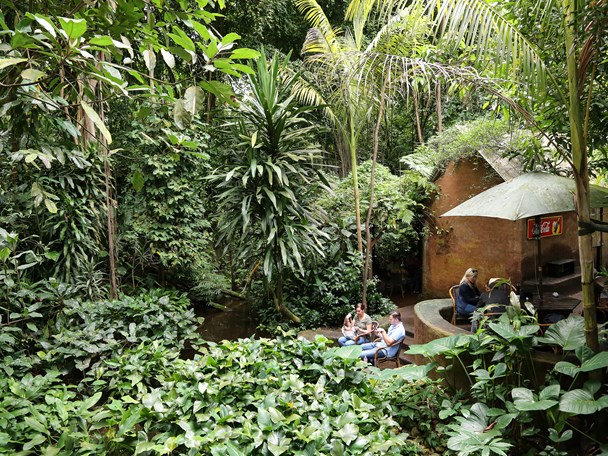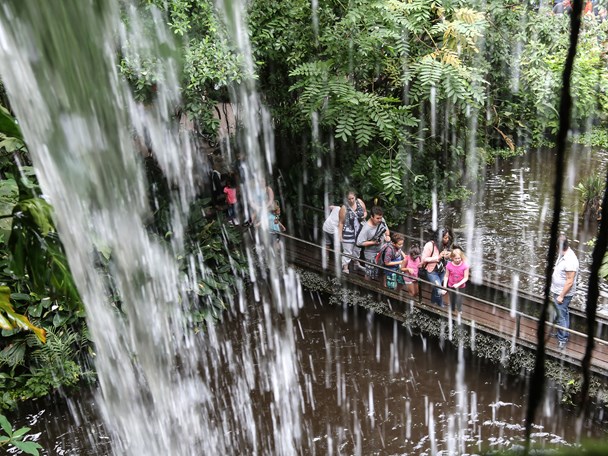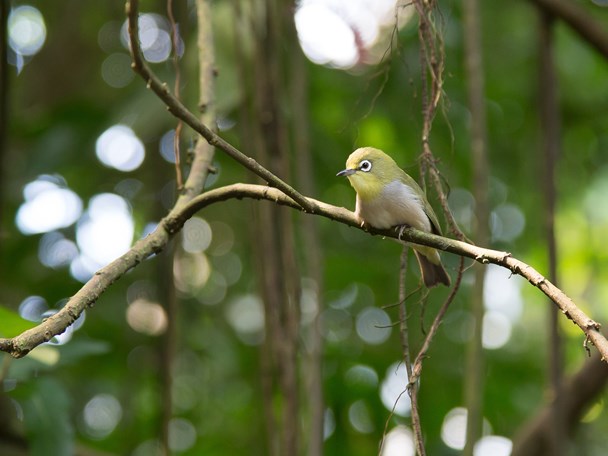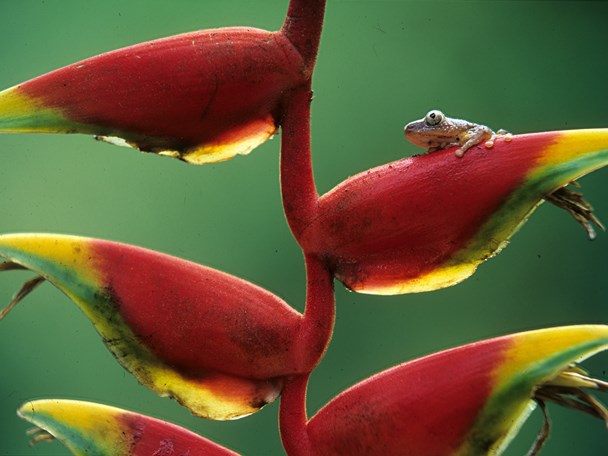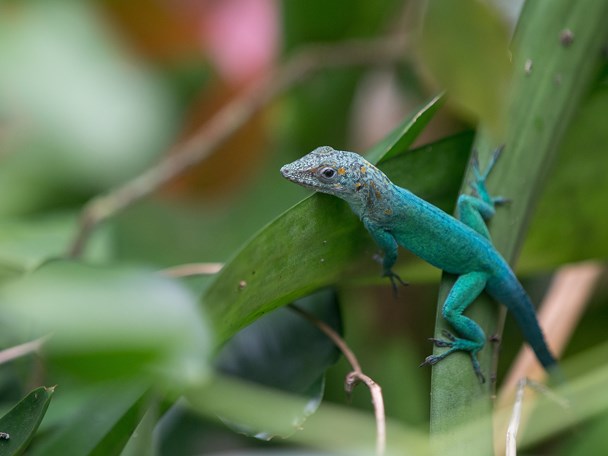When you enter the Bush, you enter the colourful world of the tropical rainforest. The humid heat, dense vegetation, smells and sounds make you feel like you are actually in the tropics! You quickly notice that the animals live in complete freedom all around you. In the water, on the ground, in the trees and in the air: this tropical rainforest holds a wealth of animals to discover! The more you look around quietly, the more you will start to notice. Some animals are treetop dwellers, while other species are mainly found on the forest floor. In the Bush, you can discover many different species of mammals, birds, fish and reptiles on your journey through the jungle.
Less adventurous visitors and people with baby carriages or wheelchairs are advised to explore the Bush from the main routes, which are easily recognisable by the wider, paved paths. From here, visitors can see all the larger animals living in their enclosures. True explorers can wander the winding adventure paths or hop across babbling brooks on stepping stones—unravelling the secrets of the rainforest is a lot of fun! The Bush is designed to invite visitors to discover it for themselves—and maybe even get lost in the jungle!
The Bush represents flora and fauna from the African, American and Asian tropics. It is always warm in a tropical rainforest climate, with high precipitation all year round. At Burgers' Bush, it rains almost every day—or rather, almost every night. The irrigation system in the roof sprays around 80,000 litres of water at night, on average. Burgers' Bush has around three to four times as much annual precipitation as the Netherlands. It's called a rain forest for a reason!
The tropical feeling in the Bush is mostly due to the combination of heat and high humidity. The gorgeous waterfall in the Bush is not just a great background for photos; it also serves as part of the climate control system by mixing warm and cold layers of air and helping to maintain the humidity level.
Recycling is an important aspect of the tropical rainforest—almost nothing is wasted. Plants decompose as quickly as they grew, once they die. Insects and other soil dwellers break down the organic matter, while fungi release the nutrients to be reabsorbed by the plant and tree root systems.
Most tropical areas are abundant in nearly all of these factors: warmth, water and light. It is a perfect environment for plants to thrive! Because many plant species can grow here, there is a lot of competition, which has led to great species diversity through adaptation throughout evolution. Plants have developed all kinds of strategies to make optimal use of the available resources. Many smaller plants live as epiphytes, which means they grow on the branches of the tall trees. Bromeliads are one such plant. Their funnel-shaped leaves help capture rainwater, as their roots cannot reach the moist soil. Frogs and some insects use these pools of water to lay their eggs. Ficuses, or figs, have a different trick up their sleeves. When their seed lands in monkey or bird droppings on a branch, the tree will start to grow from there. Aerial roots grow several meters down, forming the trunk of the banyan tree once they reach the ground. The fully-grown banyan eventually constricts its host on whose branch the seed first developed, killing it and taking its place.
There is not much wind in the middle of the rainforest. The sheer variety of plants also makes it unlikely that a grain of pollen would get blown onto the pestle of the same species. As a result, many plant species in the rainforest depend on animals for pollination: insects, as well as birds and bats, for example. These animals often find nectar in the flowers of these plants in exchange for their efforts. This type of cooperation between animal and plant species is known as a symbiosis. The species diversity of plants is the basis for the species diversity of animals in the rainforest. We have around a thousand different types of trees and plants in the Bush, making the Bush extraordinary not only because of the animal life but also because of the rare botanical collection.
A tropical rainforest is a treasure trove of biodiversity. Burgers' Bush is home to a thousand species of trees and plants, creating a perfect habitat for dozens of animal species. These species not only find their food in the tropical rainforest, but also shelter, nesting possibilities, and all kinds of other important living conditions. The interrelations within this ecosystem are highly complex and interesting.
Every year, plant caretakers prune around 25,000 kg of plant material, which grows back after just one year. A lot of the clippings are shredded and returned to the Bush, as the nutrient cycles play a major role in this ecosystem.
The animal collection in the Bush includes representatives of all classes of vertebrates. Freshwater rays, catfish and tilapia represent the group of fish. Anoles, basilisks, iguanas, turtles and a caiman represent the reptiles. Amphibians are currently only represented by Leptodactylidae, or "whistling frogs", which are mostly nocturnal. The Bush is also home to a number of mammalian species, such as the diurnal (active during the day) megabats and the nocturnal Seba's short-tailed bats. They fulfil an important role in the Bush as pollinators. Other permanent mammalian residents of the Bush include the small-clawed otter and aardvarks. Last but not least, over thirty bird species fulfil a vital role within the rich animal life in Burgers' Bush.
31 October 2022
18 Oct 2022
14 Oct 2022
7 Oct 2022
6 Sep 2022
11 Aug 2022
28 Jul 2022
26 Jul 2022
10 May 2022
20 Feb 2022
1 Oct 2021
3 Dec 2019
